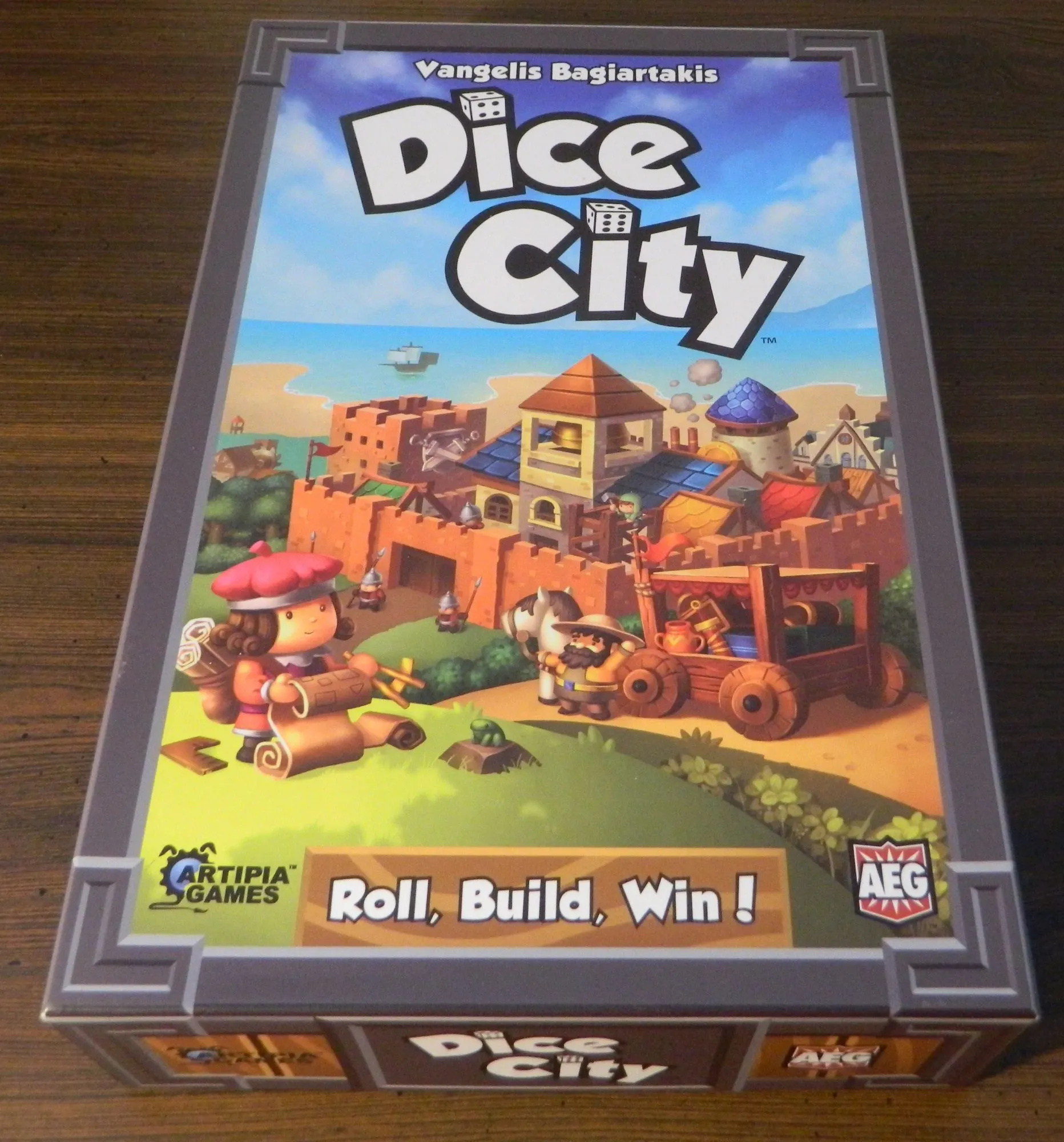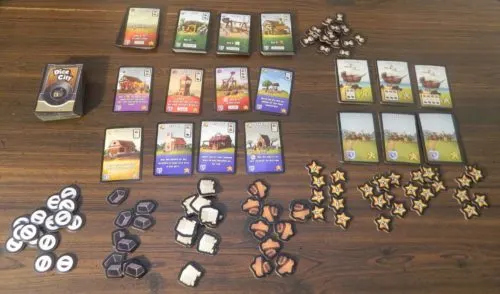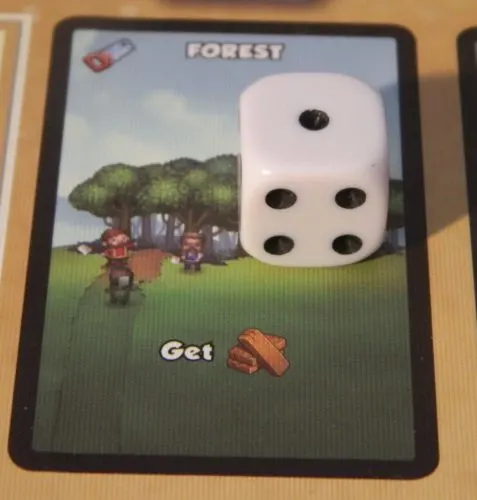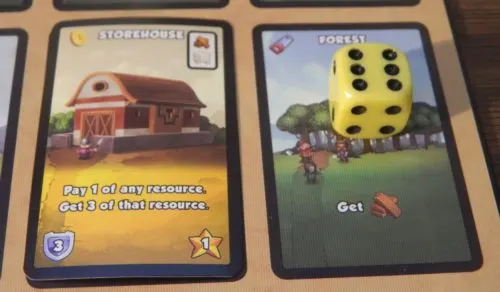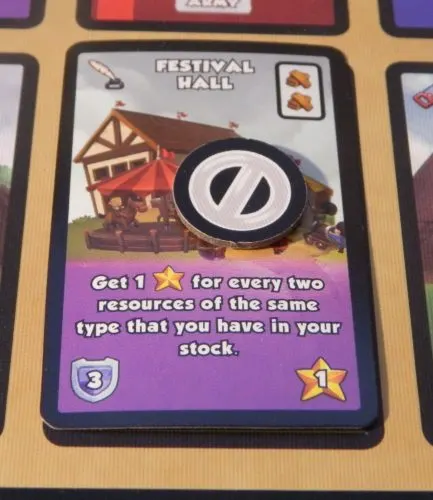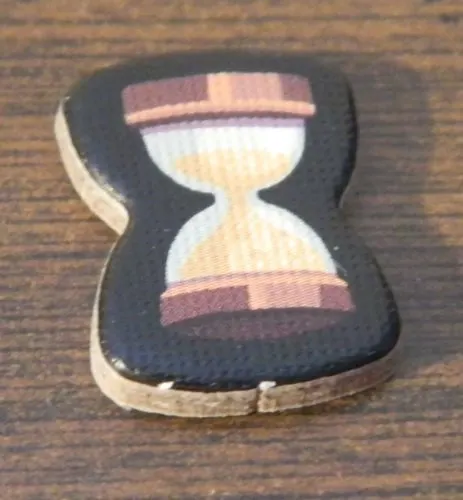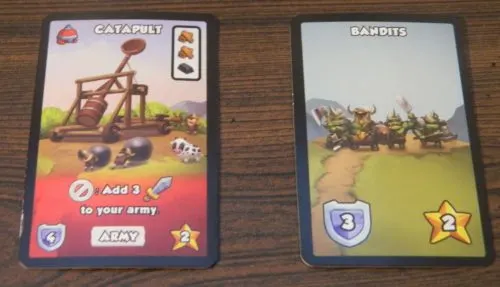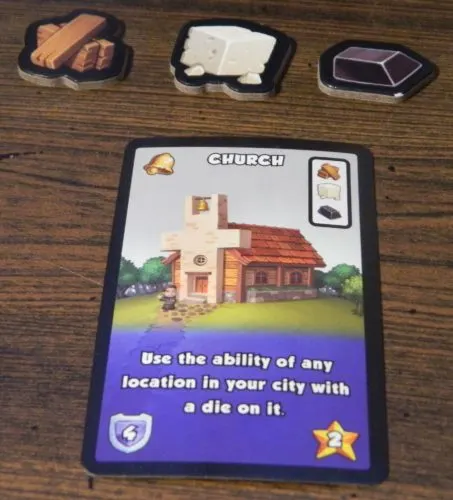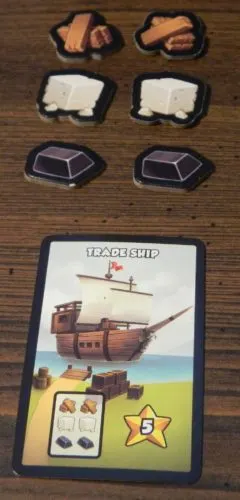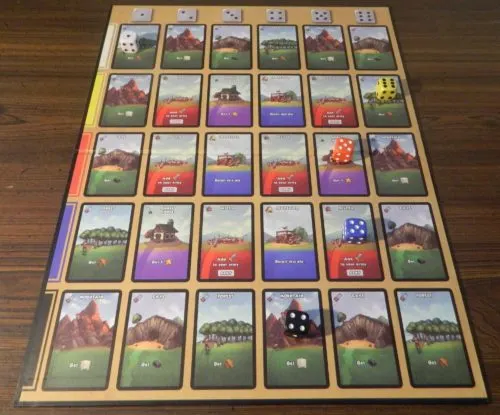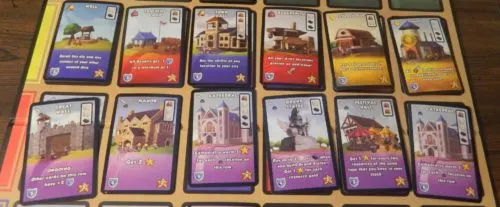In Dice City you play as the leader of a noble family. The Kingdom of Rolldovia is in trouble. After countless barbarian attacks, the Queen has decided to abandon the current capitol of the kingdom. As one of the leaders of the kingdom your goal is to convince the queen to choose your city as the new capitol. This won’t be easy though as you need to prove to your Queen that your city has more value than the other noble’s cities. This includes having a city that is well protected, has plenty of trade routes, and infrastructure to support the capitol. When you first look at Dice City the box makes the game look like a cute little city-builder. Hidden underneath the surface though is an interesting blend between a dice, city builder, worker placement and strategy game. Dice City might look like a mixture of a bunch of random mechanics but the game successfully combines them into a highly satisfying and fun game that is hard to put down.
How to Play Dice City
Setup
- Each player takes a player board and one of each color of die. The unused boards and dice are returned to the box.
- Separate the cards based on their backs. Place the lumber mill, quarry, mine and regular army cards into their own piles in the center of the table.
- Shuffle all of the location cards. Place the top eight location cards face up on the table. Set the rest of the location cards to the side as they will serve as a draw pile.
- Sort the bandit cards by their victory point values. Place a number of bandits equal to the number of players plus two for each of the three values. Each value should be placed in their own pile. All bandit cards that aren’t used are returned to the box.
- Sort the trade ships into three piles based on their victory point values. You will add the following trade ships to the table (in separate piles): 5 point ships-number of players plus two, 10 point ships-number of players, 20 point ships-one.
- Sort the various tokens by their type and form different piles.
- The player who has most recently rolled a dice will start the game. They will receive the first player token.
- All of the players will roll their five dice and place them on their boards to setup for the first round. See the “End of Turn” section below.
Playing the Game
Each player’s turn consists of four steps:
- Use Dice
- Attack
- Build and Trade
- End of Turn
Use Dice
Each player will begin their turn by using the dice that they rolled at the end of their last turn. The players have five dice and each dice will correspond to one space on their grid gameboard. Players will have the opportunity to use all five of their dice. When a player uses a dice they remove it from their board to indicate that they used the action. The dice can be used in the following ways:
- A player can use a die to take the action described on the space that the dice was placed on. If the action gives you resources or victory points, take the corresponding tokens from the supply in the middle of the table.
- A player can discard one of their dice to move one of their other dice left or right one space in the grid.
- A player can discard one of their dice to discard four of the location cards in the center of the table. The player can choose which cards they wish to discard. The location cards that are discarded are replaced with new cards from the draw pile. This action can only be taken once per turn.
- If one of your locations have been deactivated (because it was attacked by one of the other players), you can discard one die to reactivate it.
- A die can be exchanged for a pass token.
Throughout the game players will acquire pass tokens. In addition to using dice to take actions, players can turn in two pass tokens in order to take additional actions. These actions can be taken at any time during the “use dice” step.
- Take one resource token of your choice from the supply.
- Increase your army strength by one for the rest of your turn.
- Force all of the other players to re-roll one of their dice. The player who chooses this action gets to determine which die the other players have to re-roll.
Attack
After a player has used all of their dice, they have the ability to attack with their army. In the previous step players may have acquired army strength (swords). If a player acquired swords, they have the ability to use their army to attack. A player’s army strength only lasts for the current turn as your army strength is reset to zero at the beginning of each turn. When attacking a player can choose one of three targets.
First a player can choose to fight one of the groups of bandits in the middle of the table. In order to attack a bandit, the player has to have an army strength equal to or stronger than the bandits defense (shield) they are attacking. If a player is successful in defeating the bandits, they will take the card and place it face down in front of them.
A player can also choose to attack one of the other players. To attack another player’s location the attacking player’s army strength has to be equal to or larger than the defensive strength of the location they are attacking. The player can attack any location as long as it is not already deactivated and has a defensive value. If you successfully attack a location, you place a deactivation token on the location you attacked. The player who controls the location can’t use it until they get rid of the deactivation token. The attacking player will take victory point tokens equal to the victory point value of the location that was attacked.
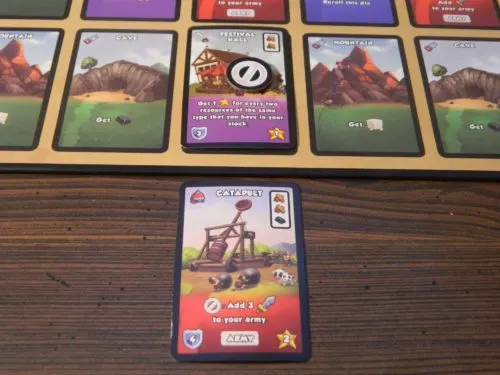
This player has used the three attack power from their catapult to attack and deactivate the other player’s festival hall.
Finally a player can use two army strength in order to steal a resource from another player.
A player can attack multiple times if they have enough army strength. Each attack uses up the corresponding army strength which can’t be used in additional attacks. The player can use the same type of attack multiple times or they can choose different types of attacks.
Building and Trading
After a player has finished the attack step, they have the ability to use the resources they acquired in the first step. Players can use resources in two different ways.
First a player can use resources in order to purchase a location. To purchase a location the player has to discard tokens equal to the symbols shown in the top right corner. When a resource is used it is returned to the supply. Once a player has purchased a location they will place it on their gameboard. A player can place a location card anywhere on their gameboard. A player can even place a card on a space that already has a card. In this case the old card is discarded and the new card takes its place. Once a card is placed it cannot be moved. Players can build as many locations as they want as long as they have enough resources.
Players can also use resources in order to acquire trade ships. If a player has all of the resources pictured on a trade ship, they can trade in the resources and take the appropriate card. The player places the card in front of them face down which will be worth victory points at the end of the game.
End of Turn
A player is able to store one wood, one iron and one stone between turns. If a player has any other wood, iron or stone; they are returned to the supply.
The player then rolls all five of their dice. Each dice is placed in the row and column corresponding to its color and the number that was rolled.
After a player has placed all of their dice on their board, play passes to the next player clockwise.
End of Game
The game ends when one of four conditions are met:
- All of the bandit cards have been taken by the players.
- All of the trade ships from two different values have been taken.
- The location deck runs out of cards.
- One of the players has placed a card on every space in two different rows. All of the location cards in these two rows can’t have a deactivation token on them. For only this condition, the player who meets it can choose not to end the game.
When one of the conditions are met, the game continues until all of the players have had the same number of turns. The game then ends.
Players count up how many points they scored during the game. Players score victory points from the following sources:
- Victory point tokens
- Bandit cards (number inside star)
- Trade ship cards (number inside star)
- Location cards on a player’s board (number inside star). A location card will still score points if it is currently deactivated.
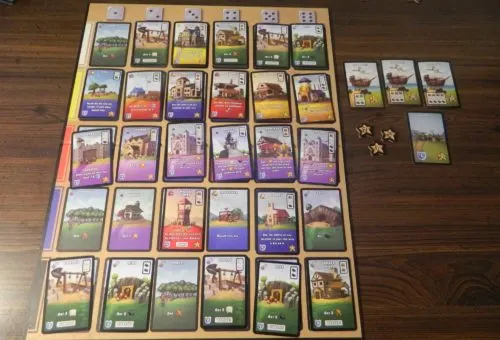
This player has scored points as follows:
7 points for point tokens
3 points for the bandits card
35 points for the trade ship cards
38 points for the location cards
They scored a total of 83 points.
The player who has acquired the most victory points wins the game. If there is a tie, the player with the most location cards on their gameboard wins. If there is still a tie, the player with the most trade ship and bandit cards wins. Finally if there is still a tie, the player closest to the starting player wins.
Solo Game
For the solo game most of the rules are the same except for the following changes:
- Whenever you would take a bandit or trade ship card, take the corresponding amount of victory point tokens instead.
- When dealing out location cards place the cards in two rows. In the normal game you will place four in each row. In the expert game place five in each row.
- When you purchase a location card, it is not replaced with a new card.
- At the end of your turn all of the location cards on the bottom row are discarded. The top row is slid down to form the new bottom row. New location cards are then drawn to form the top row.
- The game ends when you run out of location cards. In order to win the game you need to score 50 or more points.
My Thoughts on Dice City
Dice City is a really interesting game. I have played a lot of different board games and I honestly can’t think of many games that have so many unique mechanics blended together. At first Dice City looks like a pretty generic dice game. It does have the word dice in its name after all. For a dice game I was surprised by how little the dice actually were involved in the gameplay. I would consider the main mechanics in Dice City to be a combination of a city building, worker placement, and strategy game. Basically the goal is to build up your city in order to score the most points. You build up your city by assigning your workers to various locations, based on your dice rolls, which gives you resources that you can use to take further actions. With those actions you have to strategize how you want to expand in order to score more points. I have played a lot of board games and I haven’t played any games quite like Dice City. The game is such an interesting combination of different ideas and yet they work surprisingly well together. This all leads to Dice City being a really enjoyable game.
One of the first signs of a good board game in my opinion is that it only adds as much difficulty as is needed. If a mechanic mostly just adds difficulty to a game without adding any fun, it shouldn’t be in the game in the first place. Difficulty or complexity is not a precursor to a good game. Some of the best board games that I have played are simple enough that all but the youngest children can play them pretty easily. I wouldn’t go that far with Dice City but I would say that it is quite a bit easier than I originally anticipated. I would say that the game takes around ten minutes to teach to new players. Players might not know exactly what they are doing their first couple turns but you pick up the game really quickly. While I don’t think young children could play the game, I also don’t agree with the recommended age of 14+. I think kids around the ages of 10-12 shouldn’t have any troubles playing Dice City.
The reason the game is so easy to play is that the mechanics are quite straightforward. The game gives you a lot of options but most of your options are quite straightforward. Most of the game revolves around deciding how you want to use your dice and then using your attack power and other resources to acquire cards or attack other players. The most difficult part of the game is figuring out what the individual location cards do. Some of these cards are not the most straightforward and require a little clarification. As you play the game though you start to figure out how each location card is used.
The other key to a good board game is giving players enough choices where they feel like they are truly impacting the game. Dice City does a great job in this area. The numbers you roll can slightly alter what you ultimately do in Dice City, but the game gives you plenty of options to tailor your strategy to your own desires. Like to mess with other players, focus on combat and attack the other player’s buildings. Would you rather gather a bunch of resources? Use your dice to acquire resources which you can use to add locations to your city. This will give you even more resources in future turns. As your dice rolls will somewhat impact what you can do on a turn though, you need to be flexible and be willing to change your strategy when necessary.
For a dice game I have to say that I was genuinely surprised by how much strategy there is in Dice City. Luck plays a factor as well but you have a lot of impact over how well you do in the game. You might not win if luck is not on your side. You have no chance of winning though if you don’t have a good strategy. What I like about Dice City’s strategy is that the game gives you plenty of different ways to score points. This is a key for a game like Dice City as every die roll can be useful in the game. There are no wasted rolls in the game as you can do something to help yourself with any space your dice lands on. While I personally prefer certain strategies, you can craft a winning strategy with whichever route you decide to take.
I think the area where a lot of the strategy in Dice City comes from is choosing which locations to add to your city and figuring out the best place to place them. I have to say that I was actually surprised by the number of different locations found in the game. Quite a few of the locations just give you different quantities of resources. There are some locations that give you some really interesting abilities though. Some of the buildings even interact with each other which adds another layer of strategy. Choosing the right locations and placing them in the right spots on the board can give you a big advantage in the game. While you might just be buying cards and placing them on a gameboard, it actually feels like you are really building up a town.
In addition to the gameplay, I really liked the components for Dice City. First I really like the game’s art style. It is really well done and adds a unique character to the game. The cards and gameboards are well designed so you always know where you have to look to get the information you are looking for. Outside of the dice which are basic colored dice, the component quality is quite high. The cards are pretty thick and the cardboard pieces are really thick. The components are of a high enough quality that I would expect them to last a long time. The only issue I have with the components is that the player boards are quite large. Good luck fitting four of them on a normal sized kitchen table. If you want to play with four players you will either need a large table or you will have to find some kind of workaround.
While I really enjoyed Dice City, it does have some issues.
Like all dice rolling games there is a decent amount of luck to Dice City. Players who are able to roll numbers that get dice onto their best locations are going to have a pretty big advantage in the game. For a game that has quite a bit of strategy, it is always a little disappointing when your success can come down to who rolls the numbers they need at the right times. You could have a better strategy than the other players and end up losing because they had better luck than you.
I have to give the game credit though for trying to eliminate as much of the luck from the game as possible. The game gives you the ability to adjust the position of dice by discarding some of your other dice. At first I thought this was a waste of dice but when you get powerful cards on your gameboard, this action is quite enticing. You could also exchange a dice you don’t want for a pass token which you can later use for a different action. I like these additions as they let you do something with a die that you otherwise would have no use for. They don’t totally offset the luck aspect of the game though since using them gives you less dice to use than the other players.
I would say the biggest issue with Dice City is that the game does lack player interaction. Dice City plays like one of those games where everyone does their own things and then compare their scores at the end. There aren’t a lot of opportunities in the game where your actions impact the other players. The only ways you can even impact the other players is by attacking them or taking a card that another player was planning on taking. Because of these reasons, players are forced to take turns as they don’t know what the other players are going to do. This requires players to spend quite a bit of time sitting around waiting for the other players. In a smart decision players roll dice at the end of their turns which allows them to somewhat strategize for their next turn on the other players’ turns. You never know exactly what the other players are going to do though so there is a limit on how much strategizing you can do.
The area of the game that brings the most player interaction to the game is the combat. Maybe it was just me, but I wasn’t a big fan of the combat. The problem with the combat is that it just doesn’t seem that rewarding. I think you could score more points focusing on building up your city and gathering resources. This might just be my opinion though as I have never been a big fan of these type of mechanics in games. I am the type of player that prefers to build rather than attack the other players. I personally get more satisfaction out of building something up instead of tearing down the other players. Attacking other players can deactivate one of their buildings but they only have to use one of their dice in order to activate it again. You also gain a few victory points by attacking another player. Meanwhile the other players are continuing to expand setting themselves up to score more points in future rounds. I am guessing that there is a valid strategy to using the battle mechanics but I didn’t really care for it.
With how the game doesn’t have a lot of player interaction, I would say that Dice City is the type of game that is better with less players. While the game works as a four player game, there is quite a bit of downtime between your turns. Adding in the fact that it is hard to fit four gameboards on a normal sized table, I think the game works better as a two or three player game. While I didn’t try it out, I also think Dice City would work pretty well as a single player game. The single player mode doesn’t drastically change the gameplay. Since the game doesn’t have a lot of player interaction to begin with, eliminating the need to wait for the other players should lead to the single player game still being pretty satisfying.
The final issue I had with Dice City is that I think some locations are quite a bit better than others. All of the locations are beneficial to some degree, but some of the upper level locations can be really powerful if used properly. The game somewhat offsets this by making the better locations more expensive. They might be harder to acquire but they will help you quite a bit more than the lower level locations. As all of the locations are not quite equal, this puts an emphasis on being able to pick up the good locations before the other players have the opportunity.
Should You Buy Dice City?
While not quite perfect, Dice City is a great game. Dice City somehow combines a dice rolling game with a city builder, worker placement and strategy game. These mechanics don’t share a lot in common but they work really well together in Dice City. Dice City may be a little too complicated for younger children but the game is quite a bit more accessible than you would expect. This is combined with some surprisingly deep gameplay. Dice City gives players plenty of different strategic options where players are able to alter their strategy based on what they roll. Building up your city is satisfying as it gets more powerful each turn. The game does rely on some luck though like all games that utilize dice. The biggest problem with Dice City is that the game doesn’t have a lot of player interaction. Most of the time it just feels like you are playing your own game and then comparing your scores at the end of the game. Therefore it is probably best playing Dice City with less than four players.
If the concept doesn’t really appeal to you or you don’t really like city builder/worker placement/strategy games, Dice City probably won’t be for you. Otherwise I would highly recommend Dice City as it has the right combination of accessibility and strategy to appeal to a lot of people. When you have finished a game it is hard not to think about what you are going to try and do better in your next game.
If you would like to purchase Dice City you can find it online: Amazon, eBay

